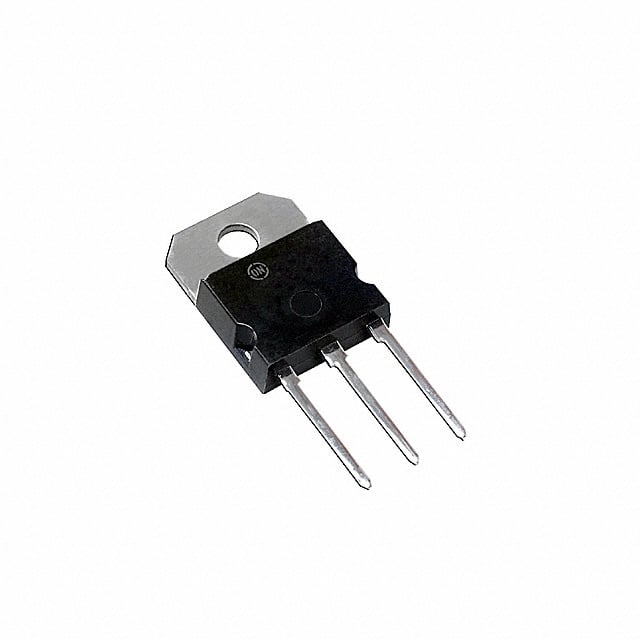MJH11022 Product Overview
Introduction
The MJH11022 is a high-power NPN bipolar junction transistor (BJT) designed for various electronic applications. This entry provides an in-depth overview of the MJH11022, including its product category, basic information, specifications, pin configuration, functional features, advantages and disadvantages, working principles, application field plans, and alternative models.
Product Category
The MJH11022 belongs to the category of high-power NPN bipolar junction transistors used in power amplification and switching applications.
Basic Information Overview
- Use: Power amplification and switching
- Characteristics: High power handling capability, low saturation voltage
- Package: TO-204AA
- Essence: High-power BJT
- Packaging/Quantity: Typically available in reels or tubes
Specifications
- Collector-Emitter Voltage (VCEO): 250V
- Collector-Base Voltage (VCBO): 300V
- Emitter-Base Voltage (VEBO): 5V
- Collector Current (IC): 16A
- Power Dissipation (PD): 250W
- Transition Frequency (FT): 30MHz
- Operating Temperature Range: -65°C to 200°C
Detailed Pin Configuration
The MJH11022 has a standard TO-204AA package with the following pin configuration: 1. Collector (C) 2. Base (B) 3. Emitter (E)
Functional Features
- High power handling capability
- Low saturation voltage
- Fast switching speed
- Robust construction for reliability
Advantages and Disadvantages
Advantages
- Suitable for high-power applications
- Low saturation voltage reduces power loss
- Fast switching speed enhances efficiency
Disadvantages
- Higher heat dissipation due to high power handling capability
- Larger physical size compared to lower power transistors
Working Principles
The MJH11022 operates based on the principles of bipolar junction transistors, utilizing the control of current flow between its collector and emitter terminals through the base terminal.
Detailed Application Field Plans
The MJH11022 finds extensive use in the following application fields: - Power amplifiers - Switching power supplies - Motor control systems - Audio amplifiers - High-power LED drivers
Detailed and Complete Alternative Models
- MJH11021
- MJH11023
- MJH11024
- MJH11025
In conclusion, the MJH11022 offers high-power capabilities and fast switching speeds, making it suitable for various power amplification and switching applications. Its robust construction and low saturation voltage are advantageous, although it may require additional heat dissipation measures due to its high power handling capability. Additionally, there are alternative models available within the MJH1102x series to cater to specific application requirements.
Word count: 410
기술 솔루션에 MJH11022 적용과 관련된 10가지 일반적인 질문과 답변을 나열하세요.
What is MJH11022?
- MJH11022 is a high-power NPN bipolar junction transistor (BJT) commonly used in power amplifier and switching applications.
What are the key specifications of MJH11022?
- The key specifications of MJH11022 include a collector-emitter voltage (Vce) of 250V, a collector current (Ic) of 16A, and a power dissipation (Pd) of 200W.
In what technical solutions can MJH11022 be used?
- MJH11022 can be used in various technical solutions such as audio amplifiers, power supplies, motor control, and electronic switches.
What are the typical operating conditions for MJH11022?
- The typical operating conditions for MJH11022 include a collector current (Ic) of 8A, a collector-emitter voltage (Vce) of 10V, and a base current (Ib) of 1.6A.
How does MJH11022 compare to other transistors in its class?
- MJH11022 offers higher power dissipation and collector current compared to many other transistors in its class, making it suitable for high-power applications.
What are the thermal characteristics of MJH11022?
- The thermal characteristics of MJH11022 include a thermal resistance junction to case (RthJC) of 1.25°C/W and a thermal resistance junction to ambient (RthJA) of 62.5°C/W.
Can MJH11022 be used in automotive applications?
- Yes, MJH11022 can be used in automotive applications such as electronic ignition systems and motor control due to its high power handling capabilities.
Are there any specific considerations for designing with MJH11022?
- Designers should consider proper heat sinking and thermal management due to the high power dissipation of MJH11022 to ensure reliable operation.
What are the recommended complementary transistors to use with MJH11022?
- Complementary transistors such as MJE11023 or similar NPN transistors can be used with MJH11022 in push-pull amplifier configurations.
Where can I find detailed application notes for using MJH11022 in technical solutions?
- Detailed application notes for using MJH11022 can be found in the manufacturer's datasheet, which provides comprehensive information on circuit design and application considerations.


